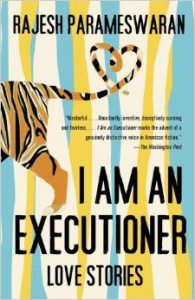
Rajesh Parameswaran’s collection of stories, I Am an Executioner, is subtitled “Love Stories.” Love stories indeed. An Indian immigrant woman tries to celebrate Thanksgiving while her husband’s newly dead body lies in the living room. A tiger on the loose mauls and kills a human baby and we feel sad for the vulnerable, loving, naïve tiger. A doctor without a license or any formal training sets up a risky medical practice. A young girl on death row meets a woman who is turned on by her situation. These are hardly the themes that come to mind when you think of love stories, but Parameswaran never delivers the expected.
I don’t want to compare a collection of short stories by an Indian American writer to Jhumpa Lahiri, but I must. Lahiri is brilliant at what she does, especially in short form. There is little dispute over that. She is the queen of the displaced immigrant story. She captures the fear and insecurities, the questions and concerns of the traditional immigrant. She understands assimilation and generational divides perfectly. But a different brand of immigrant is becoming visible these days, especially among Indian immigrants. They are not all scared, not necessarily insecure about the lingering smell of turmeric on their clothes or intimidated by the size and speed of American cars. The cultural and racial connotations once attached to the terms “expats” and “immigrants” are in flux, and the stories of these cross-cultural connections are changing with them. White people from all over the world are moving to Mumbai and Delhi in pursuit of work and wealth, and Indians are choosing to take brief sabbaticals in the United States before returning to their own work and wealth in the motherland. In many cases, the terms feel passé for what is now an increasingly global experience.
In “Demons,” the story in which an Indian woman in the United States goes about her days while her husband’s dead body lies on the floor of the living room, Parameswaran gives us a new version of the immigrant experience. Savitri, our protagonist, is not scared of driving in the United States. She is not conscious of her accent or the smell of the spices from the daal simmering on the stove. When her husband’s dead body is lying in the middle of her living room, Doug Naples, the neighbor, knocks on the door. Savitri’s husband’s legs are splayed on the ground within view of the front door. Doug notices, and asks, and Savitri responds with confidence.
She said, “Ravi is doing yoga. Yoga, Doug. That is, you know, one of the things we do in India. A very good thing.”
The white man does not make Savitri nervous. Quite the opposite. Her neighbor’s curiosity doesn’t disarm her, and elsewhere, she acknowledges and appreciates the handsomeness and masculinity of her all-American boss.
Parameswaran does occasionally drop into the usual immigrant tropes – Indian funeral rites are described with the sort of details that accompany a lot of immigrant literature.
He had died of a heart attack at an old age in the old house in the village, and they had stretched him out on the bedroom floor to clean him. Then they wrapped him in white cotton and covered his forehead with sandalwood paste and white ash and red kumkum. They moved him to the sitting room floor and laid him there. His sons didn’t shave, the stoves remained unlit. The neighbors brought over simple foods. A vadhyar came to the house to pray over the body and prepare the soul for its journey.

But the angle from which Parameswaran is arriving at these tropes is unusual enough for a lot to be forgiven. Savitri is thinking back to her grandfather’s death in India while her husband’s dead body continues to lie on the floor in her living room in America. Similarly, “The Strange Career of Dr. Raju Gopalarajan” seems, at first, to be an homage to more traditional writing. About Dr. Raju Gopalarajan’s wife, Parameswaran writes:
Her mother, of course, would be scandalized. Even some of her friends back then were scandalized. Manju had always been a shy and proper girl, they say, the last person who should have gone in for a love match.
We have read about Manju before, we think. We have read about arranged marriages and women who rebel against their parents and tradition. But in Parameswaran’s hands, Manju’s story is far from familiar. Because soon, Manju ends up married to a man who pretends to be a licensed doctor in the United States and starts to operate on unsuspecting patients, all the while telling his wife he works as a television salesman.
This collection of stories hops and skips through several genres. There is a story from the perspective of a tiger, one told by the collective “we,” and one in the form of a letter. One story feels like science-fiction, and many are humorous. There are no rules. But a few rhythms develop.
Parameswaran’s clever twists and turns feel less clever when you read the stories one after another. They risk feeling overdone. One of the weaknesses of the stories is the fine line between creating mystery and withholding information. Often it feels as though Parameswaran is simply withholding. “Narrative of Agent 97-4702” is a story about a secret agent who is working on a complicated and lengthy case that involves multiple agents and documents and files. As we read the agent’s story, a lot of the details are “[redacted]”. It’s a clever trick at first but gets tiring. Several pages in, you still know very little, too little.
Right after that, “Bibhutibhushan Mallik’s Final Story Board” goes in the opposite direction and tries to fit many stories into just a few short pages. The title character is a storyboard artist working for a renowned Bengali filmmaker while also carrying on an affair with the filmmaker’s wife. But the filmmaker has his own mistress. And all four of them have their own hopes, dreams, and anguishes. Bibhutibhushan is dealing with romance and new cities and career changes and failures and successes. Time rushes past and information is hurled at the reader. The result is far too much omission. In that story, the more that we are given, the more we are aware of what has not been given.
The diversity and experimentation of Parameswaran’s stories can be unexpected and enjoyable. But at times, one wishes Parameswaran had set clearer guidelines for his use of non-English languages, or even non-standard English. In “Bibhutibhushan Mallik’s Final Story Board,” Parameswaran peppers the pages with a few seemingly arbitrary words of Bengali. The language switch is not consistent or effective. He does not teach us bits of language like Junot Diaz does. The Bengali ends up being jarring.
Parameswaran’s stories make unexpected turns, and you find yourself sympathizing with characters you thought you would have hated. He brings a gentle empathy to the most horrifying acts, and he manages to infect us with that same empathy. I Am an Executioner is surprising and new and darkly funny. To enter the mind of Parameswaran is to be terrified and excited.




